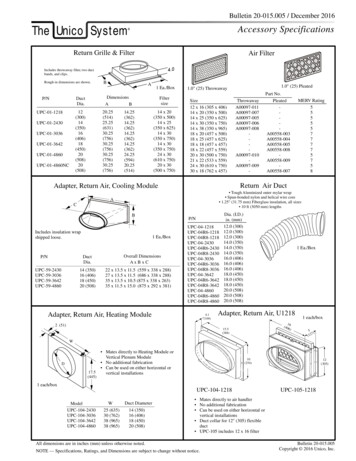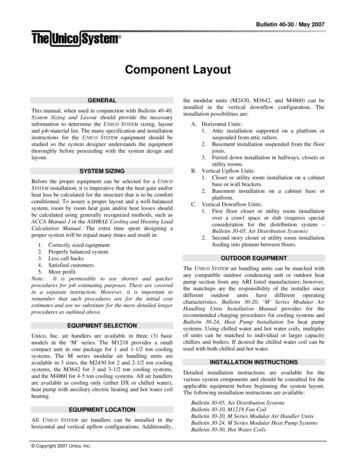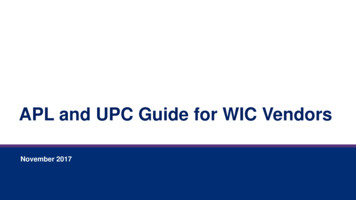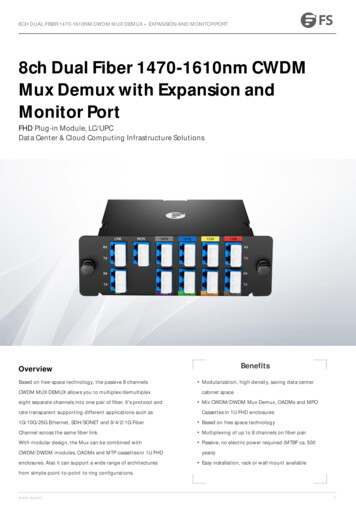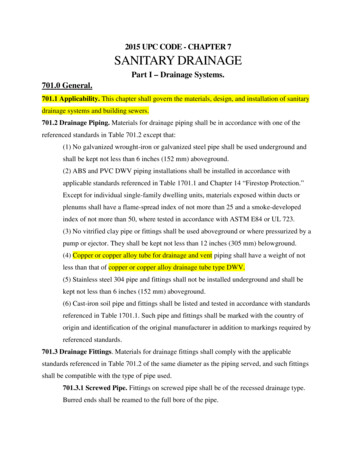
Transcription
2015 UPC CODE - CHAPTER 7SANITARY DRAINAGEPart I – Drainage Systems.701.0 General.701.1 Applicability. This chapter shall govern the materials, design, and installation of sanitarydrainage systems and building sewers.701.2 Drainage Piping. Materials for drainage piping shall be in accordance with one of thereferenced standards in Table 701.2 except that:(1) No galvanized wrought-iron or galvanized steel pipe shall be used underground andshall be kept not less than 6 inches (152 mm) aboveground.(2) ABS and PVC DWV piping installations shall be installed in accordance withapplicable standards referenced in Table 1701.1 and Chapter 14 “Firestop Protection.”Except for individual single-family dwelling units, materials exposed within ducts orplenums shall have a flame-spread index of not more than 25 and a smoke-developedindex of not more than 50, where tested in accordance with ASTM E84 or UL 723.(3) No vitrified clay pipe or fittings shall be used aboveground or where pressurized by apump or ejector. They shall be kept not less than 12 inches (305 mm) belowground.(4) Copper or copper alloy tube for drainage and vent piping shall have a weight of notless than that of copper or copper alloy drainage tube type DWV.(5) Stainless steel 304 pipe and fittings shall not be installed underground and shall bekept not less than 6 inches (152 mm) aboveground.(6) Cast-iron soil pipe and fittings shall be listed and tested in accordance with standardsreferenced in Table 1701.1. Such pipe and fittings shall be marked with the country oforigin and identification of the original manufacturer in addition to markings required byreferenced standards.701.3 Drainage Fittings. Materials for drainage fittings shall comply with the applicablestandards referenced in Table 701.2 of the same diameter as the piping served, and such fittingsshall be compatible with the type of pipe used.701.3.1 Screwed Pipe. Fittings on screwed pipe shall be of the recessed drainage type.Burred ends shall be reamed to the full bore of the pipe.
701.3.2 Threads. The threads of drainage fittings shall be tapped so as to allow 1 4 inchper foot (20.8 mm/m) grade.701.3.3 Type. Fittings used for drainage shall be of the drainage type, have a smoothinterior water-way, and be constructed so as to allow 1 4 inch per foot (20.8 mm/m)grade.701.4 Continuous Wastes. Continuous wastes and fixture tailpieces shall be constructed fromthe materials specified in Section 701.2 for drainage piping, provided, however, that suchconnections where exposed or accessible shall be permitted to be of seamless drawn brass notless than No. 20 B & S Gauge (0.032 inches) (0.8 mm).701.5 Lead. (See Table 1701.1) Sheet lead shall comply with the following:(1) For safe pans – not less than 4 pounds per square foot (lb/ft2) (19 kg/m2 ) or 1 16 ofan inch (1.6 mm) thick.(2) For flashings or vent terminals – not less than 3 lb/ft2 (15 kg/m2 ) or 0.0472 of aninch (1.1989 mm) thick.(3) Lead bends and lead traps shall be not less than 1 8 of an inch (3.2 mm) in wallthickness.701.6 CaulkingFerrules. Caulkingferrules shall bemanufactured fromcopper or copper alloyand shall be inaccordance with Table701.6.701.7 SolderingBushings. Solderingbushings shall be ofcopper or copper alloyand shall be inaccordance with Table701.7.
702.0 Fixture Unit Equivalents.702.1 Trap Size. The unit equivalent of plumbing fixtures shown in Table 702.1 shall be basedon the size of the trap required, and the unit equivalent of fixtures and devices not shown inTable 702.1 shall be based onthe size of trap or trap arm.Maximum drainagefixture units for a fixture trapand trap arm loadings for sizesup to 4 inches (100 mm) shallbe in accordance with Table702.2(1).702.2 Intermittent Flow.Drainage fixture units forintermittent flow into thedrainage system shall becomputed on the rateddischarge capacity in gallonsper minute (gpm) (L/s) inaccordance with Table702.2(2).702.3 Continuous Flow. For a continuous flow into a drainage system, such as from a pump,sump ejector, air conditioning equipment, or similar device, 2 fixture units shall be equal to eachgallon per minute (gpm) (L/s) of flow.703.0 Size of Drainage Piping.703.1 Minimum Size. The minimum sizes of vertical, horizontal, or both drainage piping shallbe determined from the total of fixture units connected thereto, and additionally, in the case ofvertical drainage pipes, in accordance with their length.703.2 Maximum Number of Fixture Units. Table 703.2 shows the maximum number of fixtureunits allowed on a vertical or horizontal drainage pipe, building drain, or building sewer of agiven size; the maximum number of fixture units allowed on a branch interval of a given size;and the maximum length (in feet and meters) of a vertical drainage pipe of a given size.
703.3 Sizing per Appendix C. For alternate method of sizing drainage piping, see Appendix C.704.0 Fixture Connections (Drainage).704.1 Inlet Fittings. Drainage piping shall be provided with approved inlet fittings for fixtureconnections, correctly located according to the size and type of fixture proposed to be connected.704.2 Single Vertical Drainage Pipe. Two fixtures set back-to-back, or side-by-side, within thedistance allowed between a trap and its vent shall be permitted to be served by a single verticaldrainage pipe provided that each fixture wastes separately into an approved double-fixture fittinghaving inlet openings at the same level.704.3 Commercial Sinks. Pot sinks, scullery sinks, dishwashing sinks, silverware sinks, andother similar fixtures shall be connected directly to the drainage system. A floor drain shall beprovided adjacent to the fixture, and the fixture shall be connected on the sewer side of the floordrain trap, provided that no other drainage line is connected between the floor drain wasteconnection and the fixture drain. The fixture and floor drain shall be trapped and vented inaccordance with this code.705.0 Joints and Connections.705.1 ABS and ABS Co-Extruded Plastic Pipe and Joints. Joining methods for ABS plasticpipe and fittings shall be installed in accordance with the manufacturer’s installation instructionsand shall comply with Section 705.1.1 through Section 705.1.3.705.1.1 Mechanical Joints. Mechanical joints shall be designed to provide a permanentseal and shall be of the mechanical or push-on joint. The push-on joint shall include anelastomeric gasket in accordance with ASTM D3212 and shall provide a compressiveforce against the spigot and socket after assembly to provide a permanent seal.705.1.2 Solvent Cement Joints. Solvent cement joints for ABS pipe and fittings shall beclean from dirt and moisture. Pipe shall be cut square and shall be deburred. Wheresurfaces to be joined are cleaned and free of dirt, moisture, oil, and other foreign material,solvent cement in accordance with ASTM D2235 shall be applied to all joint surfaces.Joints shall be made while both the inside socket surface and outside surface of pipe arewet with solvent cement. Hold joint in place and undisturbed for 1 minute after assembly.705.1.3 Threaded Joints. Threads shall comply with ASME B1.20.1. A minimum ofSchedule 80 shall be permitted to be threaded. Molded threads on adapter fittings fortransition to threaded joints shall be permitted. Thread sealant compound shall be applied
to male threads, insoluble in water, and nontoxic. The joint between the pipe andtransition fitting shall be of the solvent cement type. Caution shall be used duringassembly to prevent over tightening of the ABS components once the thread sealantcompound has been applied.705.2 Cast-Iron Pipe and Joints. Joining methods for cast-iron pipe and fittings shall beinstalled in accordance with the manufacturer’s installation instructions and shall comply withSection 705.2.1 or Section 705.2.2.705.2.1 Caulked Joints. Caulked joints shall be firmly packed with oakum or hemp and filledwith molten lead to a depth of not less than 1 inch (25.4 mm) in one continuous pour. The leadshall be caulked thoroughly at the inside and outside edges of the joint. After caulking, thefinished joint shall not exceed 1 8 of an inch (3.2 mm) below the rim of the hub. No paint,varnish, or other coatings shall be permitted on the joining material until after the joint has beentested and approved.705.2.2 Mechanical Joints and Compression Joints. Mechanical joints for cast-iron pipe andfittings shall be of the elastomeric compression type or mechanical joint couplings.Compressiontype joints with an elastomeric gasket for cast-iron hub and spigot pipe shall comply with ASTMC564 and be tested in accordance with ASTM C1563. Hub and spigot shall be clean and free ofdirt, mud, sand, and foreign materials. Cut pipe shall be free from sharp edges. Fold and insertgasket into hub. Lubricate the joint following manufacturer’s instructions. Insert spigot into hub
until the spigot end of the pipe bottom out in the hub. Use the same procedure for the installationof fittings.A mechanical joint shielded coupling type for hubless cast-iron pipe and fittings shall have ametallic shield in accordance with ASTM A1056, ASTM C1277, ASTM C1540, or CISPI 310.The elastomeric gasket shall comply with ASTM C564. Hubless cast-iron pipe and fittings shallbe clean and free of dirt, mud, sand, and foreign materials. Cut pipe shall be free from sharpedges. Gasket shall be placed on the end of the pipe or fitting and the stainless steel shield andclamp assembly on the end of the other pipe or fitting. Pipe or fittings shall be seated against thecenter stop inside the elastomeric sleeve. Slide the stainless steel shield and clamp assembly intoposition centered over the gasket and tighten. Bands shall be tightened using an approvedcalibrated torque wrench specifically set by the manufacturer of the couplings705.3 Copper or Copper Alloy Pipe (DWV) and Joints. Joining methods for copper or copperalloy pipe and fittings shall be installed in accordance with the manufacturer’s installationinstructions and shall comply with Section 705.3.1 through Section 705.3.4.705.3.1 Brazed Joints. Brazed joints between copper or copper alloy pipe and fittingsshall be made with brazing alloys having a liquid temperature above 1000 F (538 C).The joint surfaces to be brazed shall be cleaned bright by either manual or mechanicalmeans. Piping shall be cut square and reamed to full inside diameter. Brazing flux shallbe applied to the joint surfaces where required by manufacturer’s recommendation.Brazing filler metal in accordance with AWS A5.8 shall be applied at the point where thepipe or tubing enters the socket of the fitting.705.3.2 Mechanical Joints. Mechanical joints in copper or copper alloy piping shall bemade with a mechanical coupling with grooved end piping or approved joint designed forthe specific application.705.3.3 Soldered Joints. Soldered joints between copper or copper alloy pipe and fittingsshall be made in accordance with ASTM B828 with the following sequence of jointpreparation and operation as follows: measuring and cutting, reaming, cleaning, fluxing,assembly and support, heating, applying the solder, cooling, and cleaning. Pipe shall becut square and reamed to the full inside diameter including the removal of burrs on theoutside of the pipe. Surfaces to be joined shall be cleaned bright by manual or mechanicalmeans. Flux shall be applied to pipe and fittings and shall be in accordance with ASTM
B813, and shall become noncorrosive and nontoxic after soldering. Insert pipe into thebase of the fitting and remove excess flux. Pipe and fitting shall be supported to ensure auniform capillary space around the joint. Heat shall be applied using an air or fuel torchwith the flame perpendicular to the pipe using acetylene or an LP gas. Preheating shalldepend on the size of the joint. The flame shall be moved to the fitting cup and alternatebetween the pipe and fitting. Solder in accordance with ASTM B32 shall be applied tothe joint surfaces until capillary action draws the molten solder into the cup. Jointsurfaces shall not be disturbed until cool and any remaining flux residue shall be cleaned.705.3.4 Threaded Joints. Threaded joints for copper or copper alloy pipe shall be madewith pipe threads in accordance with ASME B1.20.1. Thread sealant tape or compoundshall be applied only on male threads, and such material shall be approved types,insoluble in water, and nontoxic.705.4 Galvanized Steel Pipe and Joints. Joining methods for galvanized steel pipe and fittingsshall be installed in accordance with the manufacturer’s installation instructions and shall complywith Section 705.4.1 or Section 705.4.2.705.4.1 Mechanical Joints. Mechanical joints shall be made with an elastomeric gasket.705.4.2 Threaded Joints. Threaded joints shall be made with pipe threads in accordancewith ASME B1.20.1. Thread sealant tape or compound shall be applied only on malethreads, and such material shall be of approved types, insoluble in water, and nontoxic.705.5 PVC and PVC Co-Extruded Plastic Pipe and Joining Methods. Joining methods forPVC plastic pipe and fittings shall be installed in accordance with the manufacturer’s installationinstructions and shall comply with Section 705.5.1 through Section 705.5.3.705.5.1 Mechanical Joints. Mechanical joints shall be designed to provide a permanentseal and shall be of the mechanical or push-on joint type. The push-on joint shall includean elastomeric gasket in accordance with ASTM D3212 and shall provide a compressiveforce against the spigot and socket after assembly to provide a permanent seal.705.5.2 Solvent Cement Joints. Solvent cement joints for PVC pipe and fittings shall beclean from dirt and moisture. Pipe shall be cut square and pipe shall be deburred. Wheresurfaces to be joined are cleaned and free of dirt, moisture, oil, and other foreign material,apply primer purple in color in accordance with ASTM F656. Primer shall be applieduntil the surface of the pipe and fitting is softened. Solvent cements in accordance with
ASTM D2564 shall be applied to all joint surfaces. Joints shall be made while both theinside socket surface and outside surface of pipe are wet with solvent cement. Hold jointin place and undisturbed for 1 minute after assembly.705.5.3 Threaded Joints. Threads shall comply with ASME B1.20.1. A minimum ofSchedule 80 shall be permitted to be threaded. Molded threads on adapter fittings fortransition to threaded joints shall be permitted. Thread sealant compound that iscompatible with the pipe and fitting, insoluble in water, and nontoxic shall be applied tomale threads. The joint between the pipe and transition fitting shall be of the solventcement type. Caution shall be used during assembly to prevent over tightening of thePVC components once the thread sealant has been applied. Female PVC threaded fittingsshall be used with plastic male threads only.705.6 Stainless Steel Pipe and Joints. Joining methods for stainless steel pipe and fittings shallbe installed in accordance with the manufacturer’s installation instructions and shall comply withSection 705.6.1 or Section 705.6.2.705.6.1 Mechanical Joints. Mechanical joints between stainless steel pipe and fittingsshall be of the compression, grooved coupling, hydraulic pressed fittings, or flanged.705.6.2 Welded Joints. Welded joints between stainless steel pipe and fittings shallcomply with ASME A112.3.1 and shall be welded autogenously. Pipe shall be cleaned,free of scale and contaminating particles. Pipe shall be cut with a combination cutting andbeveling tool that provides a square cut, and free of burrs. Mineral oil lubricant shall beused during the cutting and beveling process.705.7 Vitrified Clay Pipe and Joints. Joining methods for vitrified clay pipe and fittings shallbe installed in accordance with the manufacturer’s installation instructions and shall comply withSection 705.7.1.705.7.1 Mechanical Joints. Mechanical joints shall be designed to provide a permanentseal and shall be of the mechanical or push-on joint type. The push-on joint shall includean elastomeric gasket in accordance with ASTM C425 and shall provide a compressiveforce against the spigot and socket after assembly to provide a permanent seal.705.8 Special Joints. Special joints shall comply with Section 705.8.1 through Section 705.8.4.705.8.1 Slip Joints. In fixture drains and traps, slip joints of approved materials shall bepermitted to be used in accordance with their approvals.
705.8.2 Expansion Joints. Expansion joints shall be accessible, except where in ventpiping or drainage stacks, and shall be permitted to be used where necessary to providefor expansion and contraction of the pipes.705.8.3 Ground Joint, Flared, or Ferrule Connections. Copper or copper alloygroundjoint, flared, or ferrule-type connections that allow adjustment of tubing, butprovide a rigid joint where made up, shall not be considered as slip joints.705.8.4 Transition Joint. A solvent cement transition joint between ABS and PVCbuilding drain and building sewer shall be made using listed transition solvent cement inaccordance with ASTM D3138.705.9 Joints Between Various Materials. Joints between various materials shall be installed inaccordance with the manufacturer’s installation instructions and shall comply with Section705.9.1 through Section 705.9.4. Mechanical couplings used to join different materials shall bein accordance with ASTM C1173 for belowground use, ASTM C1460 for aboveground use, orASTM C1461 for aboveground and belowground use.705.9.1 Copper or Copper Alloy Pipe to CastIron Pipe.Joints from copper or copperalloy pipe or tubing to cast-iron pipe shall be made with a listed compression type joint orcopper alloy ferrule. The copper or copper alloy pipe or tubing shall be soldered orbrazed to the ferrule and the ferrule shall be joined to the cast-iron hub by a compressionor caulked joint.705.9.2 Copper or Copper Alloy Pipe to Threaded Pipe Joints.Joints from copper orcopper alloy pipe or tubing to threaded pipe shall be made by the use of a listed copperalloy adapter or dielectric fitting. The joint between the copper or copper alloy pipe andthe fitting shall be a soldered or brazed, and the connection between the threaded and thefittings shall be made with a standard pipe size threaded joint.705.9.3 Plastic Pipe to Other Materials. Where connecting plastic pipe to other types ofplastic or other types of piping material; approved listed adapter or transition fittings andlisted for the specific transition intended shall be used.705.9.4 Stainless Steel Pipe to Other Materials. Where connecting stainless steel pipeto other types of piping, listed mechanical joints of the compression type and listed forthe specific transition intended shall be used.
706.0 Changes in Direction of Drainage Flow.706.1 Approved Fittings. Changes in direction of drainage piping shall be made by theappropriate use of approved fittings and shall be of the angles presented by a one-sixteenth bend,one-eighth bend, or one-sixth bend, or other approved fittings of equivalent sweep.706.2 Horizontal to Vertical. Horizontal drainage lines, connecting with a vertical stack, shallenter through 45 degree(0.79 rad) wye branches, 60 degree (1.05 rad) wye branches,combination wye and one-eighth bend branches, sanitary tee or sanitary tapped tee branches, orother approved fittings of equivalent sweep. No fitting having more than one inlet at the samelevel shall be used unless such fitting is constructed so that the discharge from one inlet cannotreadily enter any other inlet. Double sanitary tees shall be permitted to be used where the barrelof the fitting is not less than two pipe sizes larger than the largest inlet, (pipe sizes recognized forthis purpose are 2 inches, 21 2 inches, 3 inches, 31 2 inches, 4 inches, 41 2 inches, 5 inches, 6inches, etc.) (50 mm, 65 mm, 80 mm, 90 mm, 100 mm, 115 mm, 125 mm, 150 mm, etc.).706.3 Horizontal to Horizontal. Horizontal drainage lines connecting with other horizontaldrainage lines shall enter through 45 degree (0.79 rad) wye branches, combination wye and oneeighth bend branches, or other approved fittings of equivalent sweep.706.4 Vertical to Horizontal. Vertical drainage lines connecting with horizontal drainage linesshall enter through 45 degree(0.79 rad) wye branches, combination wye and one-eighth bendbranches, or other approved fittings of equivalent sweep. Branches or offsets of 60 degrees (1.05rad) shall be permitted to be used where installed in a true vertical position.707.0 Cleanouts.707.1 Plug. Each cleanout fitting for cast-iron pipe shall consist of a cast-iron or copper alloybody and an approved plug. Each cleanout for galvanized wrought-iron, galvanized steel, copper,or copper alloy pipeshall consist of a plugas specified in Table707.1, or a standardweight copper alloycap, or an approvedABS or PVC plastic
plug, or an approved stainless steel cleanout or plug. Plugs shall have raised square heads orapproved countersunk rectangular slots.707.2 Approved. Each cleanout fitting and each cleanout plug or cap shall be of an approvedtype.707.3 Watertight and Gastight. Cleanouts shall be designed to be watertight and gastight.707.4 Location. Each horizontal drainage pipe shall be provided with a cleanout at its upperterminal, and each run of piping, that is more than 100 feet (30 480 mm) in total developedlength, shall be provided with a cleanout for each 100 feet (30 480 mm), or fraction thereof, inlength of such piping. An additional cleanout shall be provided in a drainage line for eachaggregate horizontal change in direction exceeding 135 degrees (2.36 rad).A cleanout shall beinstalled above the fixture connection fitting, serving each urinal, regardless of the location of theurinal in the building.Exceptions:(1) Cleanouts shall be permitted to be omitted on a horizontal drain line less than 5 feet(1524 mm) in length unless such line is serving sinks or urinals.(2) Cleanouts shall be permitted to be omitted on a horizontal drainage pipe installed ona slope of 72 degrees (1.26 rad) or less from the vertical angle (one-fifth bend).(3) Excepting the building drain, its horizontal branches, and urinals, a cleanout shallnot be required on a pipe or piping that is above the floor level of the lowest floor of thebuilding.(4) An approved type of two-way cleanout fitting, installed inside the building wall nearthe connection between the building drain and the building sewer or installed outside of abuilding at the lower end of a building drain and extended to grade, shall be permitted tobe substituted for an upper terminal cleanout.707.5 Cleaning. Each cleanout shall be installed so that it opens to allow cleaning in thedirection of flow of the soil or waste or at right angles thereto and, except in the case of wyebranch and end-of-line cleanouts, shall be installed vertically above the flow line of the pipe.707.6 Extension. Each cleanout extension shall be considered as drainage piping and each 90degree (1.57 rad) cleanout extension shall be extended from a wye-type fitting or other approvedfitting of equivalent sweep.707.7 Interceptor. Each cleanout for an interceptor shall be outside of such interceptor.
707.8 Access. Each cleanout, unless installed under an approved cover plate, shall be abovegrade, readily accessible, and so located as to serve the purpose for which it is intended.Cleanouts located under cover plates shall be so installed as to provide the clearances andaccessibility required by this section.707.9 Clearance. Each cleanout in piping 2 inches (50 mm) or less in size shall be so installedthat there is a clearance of not less than 18 inches (457 mm) in front of the cleanout. Cleanouts inpiping exceeding 2 inches (50 mm)shall have a clearance of not less than 24 inches (610 mm) infront of the cleanout. Cleanouts in under-floor piping shall be extended to or above the finishedfloor or shall be extended outside the building where there is less than 18 inches (457 mm)vertical overall, allowing for obstructions such as ducts, beams, and piping, and 30 inches of(762 mm) horizontal clearance from the means of access to such cleanout. No under-floorcleanout shall be located exceeding 5 feet (1524 mm) from an access door, trap door, or crawlhole.707.10 Fittings. Cleanout fittings shall be not less in size than those given in Table 707.1.707.11 Pressure Drainage Systems. Cleanouts shall be provided for pressure drainage systemsas classified under Section 710.7.707.12 Countersunk Cleanout Plugs. Countersunk cleanout plugs shall be installed whereraised heads cause a hazard.707.13 Hubless Blind Plugs. Where a hubless blind plug is used for a required cleanout, thecomplete coupling and plug shall be accessible for removal or replacement.707.14 Trap Arms. Cleanouts for trap arms shall be installed in accordance with Section 1002.3.708.0 Grade of Horizontal Drainage Piping.708.1 General. Horizontal drainage piping shall be run in practical alignment and a uniformslope of not less than 1 4 inch per foot (20.8 mm/m) or 2 percent toward the point of disposalprovided that, where it is impractical due to the depth of the street sewer, to the structuralfeatures, or to the arrangement of a building or structure to obtain a slope of 1 4 inch per foot(20.8 mm/m) or 2 percent, such pipe or piping 4 inches (100 mm) or larger in diameter shall bepermitted to have a slope of not less than 1 8 inch per foot (10.4 mm/m) or 1 percent, where firstapproved by the Authority Having Jurisdiction.
709.0 Gravity Drainage Required.709.1 General. Where practicable, plumbing fixtures shall be drained to the public sewer orprivate sewage disposal system by gravity.710.0 Drainage of Fixtures Located Below the Next Upstream Manhole orBelow the Main Sewer Level.710.1 Backflow Protection. Fixtures installed on a floor level that is lower than the nextupstream manhole cover of the public or private sewer shall be protected from backflow ofsewage by installing an approved type of backwater valve. Fixtures on such floor level that arenot below the next upstream manhole cover shall not be required to be protected by a backwatervalve. Fixtures on floor levels above such elevation shall not discharge through the backwatervalve. Cleanouts for drains that pass through a backwater valve shall be clearly identified with apermanent label stating “backwater valve downstream.”710.2 Sewage Discharge. Drainage piping serving fixtures that are located below the crownlevel of the main sewer shall discharge into an approved watertight sump or receiving tank, solocated as to receive the sewage or wastes by gravity. From such sump or receiving tank, thesewage or other liquid wastes shall be lifted and discharged into the building drain or buildingsewer by approved ejectors, pumps, or other equally efficient approved mechanical devices.710.3 Sewage Ejector and Pumps. A sewage ejector or sewage pump receiving the discharge ofwater closets or urinals:(1) Shall have a discharge capacity of not less than 20 gpm (1.26 L/s).(2) In single dwelling units, the ejector or pump shall be capable of passing a 11 2 inch(38 mm) diameter solid ball, and the discharge piping of each ejector or pump shall havea backwater valve and gate valve, and be not less than 2 inches (50 mm) in diameter.(3) In other than single-dwelling units, the ejector or pump shall be capable of passing a 2inch (51 mm) diameter solid ball, and the discharge piping of each ejector or pump shallhave a backwater valve and gate valve, and be not less than 3 inches (80 mm) indiameter.710.4 Discharge Line. The discharge line from such ejector, pump, or other mechanical deviceshall be of approved pressure rated material and be provided with an accessible backwater orswing check valve and gate or ball valve. Where the gravity drainage line to which suchdischarge line connects is horizontal, the method of connection shall be from the top through a
wye branch fitting. The gate or ball valve shall be located on the discharge side of the backwateror check valve.Gate or ball valves, where installed in drainage piping, shall be fullway type withworking parts of corrosion-resistant metal. Sizes 4 inches (100 mm) or more in diameter shallhave cast-iron bodies, and sizes less than 4 inches (100 mm), cast-iron or copper alloy bodies.710.5 Size of Building Drains and Sewers. Building drains or building sewers receivingdischarge from a pump or ejector shall be adequately sized to prevent overloading. Two fixtureunits shall be allowed for each gallon per minute (L/s) of flow.710.6 Backwater Valves. Backwater valves, gate valves, fullway ball valves, unions, motors,compressors, air tanks, and other mechanical devices required by this section shall be locatedwhere they will be accessible for inspection and repair and, unless continuously exposed, shall beenclosed in a masonry pit fitted with an adequately sized removable cover.Backwater valves shall comply with ASME A112.14.1, and have bodies of cast-iron,plastic, copper alloy, or other approved materials; shall have noncorrosive bearings, seats, andself-aligning discs; and shall be constructed so as to ensure a positive mechanical seal. Suchbackwater valves shall remain open during periods of low flows to avoid screening of solids andshall not restrict capacities or cause excessive turbulence during peak loads. Unless otherwiselisted, valve access covers shall be bolted type with gasket, and each valve shall bear themanufacturer’s name cast into the body and the cover.710.7 Drainage and Venting Systems. The drainage and venting systems, in connection withfixtures, sumps, receiving tanks, and mechanical waste-lifting devices, shall be installed underthe same requirements as provided for in this code for gravity systems.710.8 Sump and Receiving Tank Construction. Sumps and receiving tanks shall be watertightand shall be constructed of concrete, metal, or
2015 UPC CODE - CHAPTER 7 . SANITARY DRAINAGE . Part I - Drainage Systems. 701.0 General. 701.1 Applicability. This chapter shall govern the materials, design, and installation of sanitary . The unit equivalent of plumbing fixtures shown in Table 702.1 shall be based on the size of the trap required, and the unit equivalent of fixtures and .





